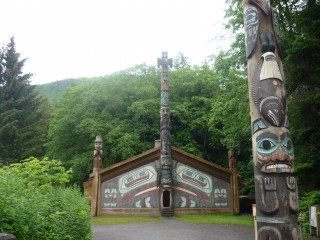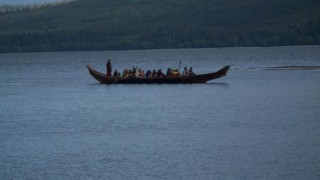This content was published: December 16, 2010. Phone numbers, email addresses, and other information may have changed.
Pacific Northwest Native culture: Up close and very personal
Photos and story by Abe Proctor
One of the basic challenges facing Charlie Presti each day in the classroom is the same one faced by teachers of history everywhere – making history live and breathe, connecting with the events of the past in a meaningful way.

Cascade instructor Charlie Presti spent much of his time meeting with native artists, weavers, carvers and musicians, learning how they have combined traditional forms with modern media and styles.
The Cascade Campus faculty member had a rare opportunity to do just that this past summer when he took part in “Native Cultures of Western Alaska and the Pacific Northwest,” a sort of traveling series of cultural workshops that took him to Native American communities along the Northwest Pacific coast.
“It was an incredible trip,” said Presti, who teaches Native American history, Oregon history and a survey of Western civilization at Cascade. “I got to travel with a pretty renowned roster of prestigious scholars – archaeologists, anthropologists, art historians … many of them are top names in their fields.”
The four-week traveling seminar took Presti and his colleagues to Native American communities near the Alaskan cities of Juneau, Sitka and Ketchikan, as well as to numerous sites in British Columbia. Presti’s focus during these visits was on how native cultures in the area have changed as the mainstream culture has modernized, particularly in terms of their art and social organization.
Presti spent much of his time meeting with native artists, weavers, carvers and musicians, learning how they have combined traditional forms with modern media and styles. He also met with tribal chiefs, politicians and elders.
“The region is home to one of the most complex indigenous art cultures in the world,” he said, “and some of the artists I visited derive a modest income from selling their art to outsiders.”
This is especially true of the sites he visited in Alaska, where the cruise-ship tourist industry puts the tribes in contact with outsiders by the thousands. The tribes have attempted to benefit economically from this contact in a number of ways, such as through the sale of art, and also – in the case of the Haida tribes of Queen Charlotte Island, for example – by constructing their own cultural centers for tourists to visit.
Presti also discovered, however, that the modern tourist economy – and who benefits from it – underscores longstanding social and economic divisions within the tribes themselves.

“It’s inspired me to do more research and write more,” Presti said of his adventure. “It’s one of the coolest things I’ve ever done.”
“Tribal relations in Alaska are different than they are in the Lower 48,” Presti said. “Individuals are members of tribes, but also shareholders in tribal corporations.”
This arrangement, he said, has led to new forms of stratification among cultures that have long existed at the economic and political margins of mainstream society. The corporations play a large role in how the tribal economy functions, including the extraction of natural resources from tribal lands. The 12 regional tribal corporations were created by an act of Congress in 1971, and each Native Alaskan at the time was granted shares in his or her regional corporation. Since then, Presti said, some of the corporations have not extended shares to tribal members who were born after 1971 – effectively disenfranchising generations of younger Native Alaskans.
“It has definitely been divisive,” Presti said. “It’s created a culture of haves and have-nots, particularly in more resource-rich areas.”
In addition to providing him with food for thought, Presti said his summertime odyssey will benefit him – and his students – in the classroom.
“It’s inspired me to do more research and write more,” he said. “It will enhance my curriculum considerably. I’m far better able to describe the cultures I visited.
“It’s one of the coolest things I’ve ever done.”
